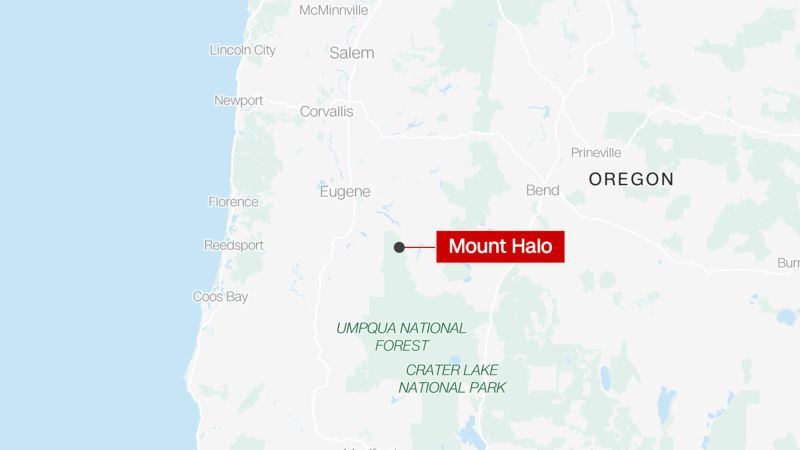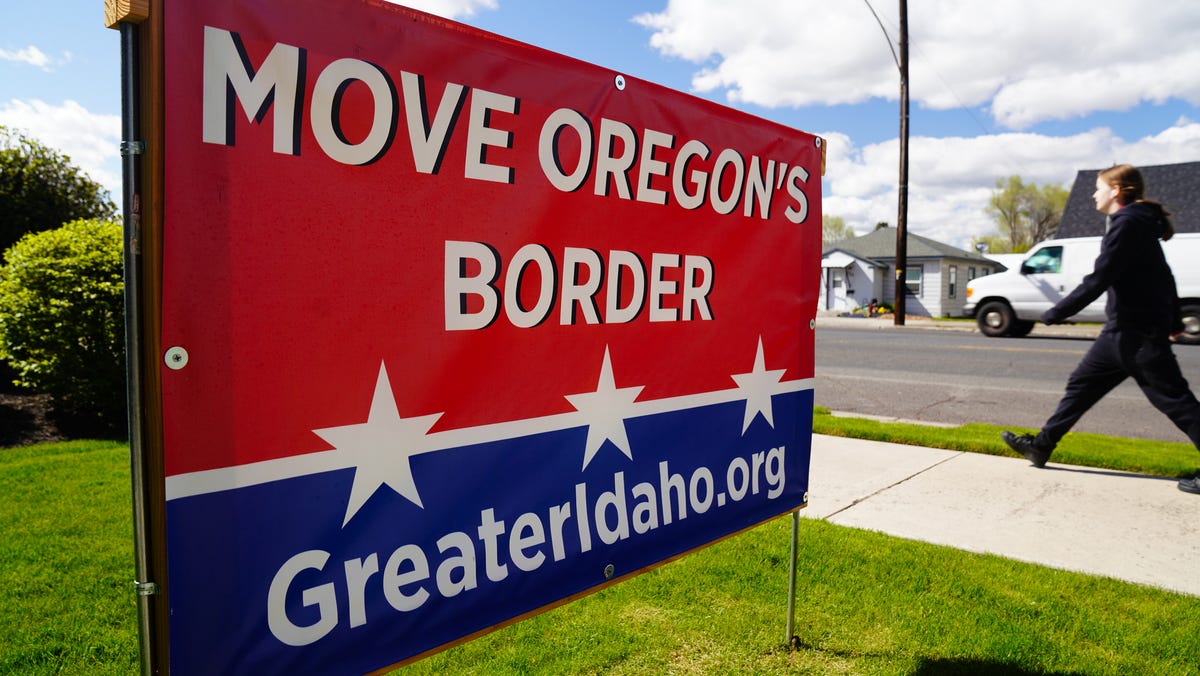An Oregon ballot initiative is the latest in a long line of secession efforts that speak to the nation’s sharp divide.
Can a state actually secede?
A growing number of Americans are in favor of a national divorce. What’s the likelihood of secession by states like Texas or California?
Straight Arrow News
PRINEVILLE, Oregon ‒ Tens of thousands of rural, conservative eastern Oregon residents are so frustrated with their liberal urban neighbors they’ve decided they can no longer even share a ZIP code.
The “Greater Idaho Movement” would shift the Oregon border 200 miles west, a secession effort aligning the conservative farming, ranching and logging communities of eastern Oregon with their like-minded neighbors to the east. A dozen counties in eastern Oregon have already approved the plan, and voters in Crook County and the county seat of Prineville are currently considering the non-binding measure with results due Tuesday.
“I love Oregon but I just don’t love the people running it right now,” said Eric Smith, 48, who owns two retail shops on Prineville’s main street. “It doesn’t feel like they want to keep us anyway.”
Across Crook County, pop. 26,325, even voters who oppose the measure say they’re tired of the dictates from liberal lawmakers in the state capital of Salem and the state’s population center of Portland, citing marijuana legalization, efforts to reduce fossil fuel use, gun-control measures and how the state handled the coronavirus pandemic.
The sentiment in eastern Oregon reflects a broader national frustration and divide over the direction of the country that’s playing out in school districts, university campuses and big cities, all the way up to Congress.
A 2023 study by a Colby College professor found that more than 25% of Americans support some sort of secession by states, and nearly 25% percent agreed it “makes sense to split the country up.”
Georgia Rep. Marjorie Taylor Greene, a Republican, highlighted the division many Americans feel when she tweeted in February 2023 that “we need a national divorce. We need to separate by red states and blue states and shrink the federal government…”
Ryan D. Griffiths, a political science professor at Syracuse University, said the Oregon ballot initiative is the latest in a long line of efforts, though most have never amounted to more than slogans and bumper stickers. Among them: the failed “State of Jefferson” proposal in Northern California, simmering secession movements in Vermont and Texas, and a short-lived effort to move a chunk of Northern Colorado into Wyoming.
Griffiths said like other secession efforts, the Greater Idaho Movement lacks a significant groundswell of public support, and in most cases is more of a referendum on state-level governance.
“It’s a pipe dream, in a way. What they’re doing is partly performative, for ideological purposes,” he said. “A lot of time, secessionist movements are really just bargaining efforts.”
Griffiths said scholars who study secession efforts, like those of the former U.S.S.R., see U.S.-based movements as “pretty lightweight stuff.” But he also acknowledged secession efforts like Greater Idaho keep bubbling up.
“It’s gaining a weird creeping momentum,” he said of proposed partisan divorces.
“If you imagine a full-blown project to divide America into red and blue states, that would be incredibly dangerous because you’d have to partition people off,” he said. “You don’t actually have neatly sorted populations, despite what many people think.”
Should neighbors share the same values?
In Oregon, the measure’s backers say they’re using a peaceful, existing political process to reduce friction between people at opposite ends of the political spectrum who are already living separate lives within the state. Supporters say they don’t want to just sell their homes and move to another state because they like living where they are.
“People have already sorted themselves into like-minded communities,” said Matt McCaw, a Greater Idaho movement spokesman. “People like to live around people who share the same values they do.”
Smith, the shop owner, used to live in nearby Bend, part of the far more liberal Deschutes County, but left in frustration over its political direction.
In the 2020 presidential election, Deschutes County voted 52% for Joe Biden, while Crook County, where he now lives, gave Trump 73% of its vote. The measure’s backers say they likely won’t seek support from Deschutes voters, even though the county is considered part of eastern Oregon.
Smith said he’s not sure how he’ll vote on secession, but he understands why people support it.
“Quit treating us like Portland,” he said, echoing the sentiment of many Crook County residents.
Experts say the kind of self-segregation decisions people like Smith make are reflected in recent migrations nationally to states like Texas and Florida, but also in the “white flight” movement of the 1950s and 1960s, as white city-dwellers moved to the suburbs.
The Greater Idaho movement would need approval from both Oregon and Idaho’s legislatures, along with Congress. Also undetermined would be how the Native American reservations in Eastern Oregon would be incorporated, as they span county and state borders.
McCaw, a foster parent who lives north of Prineville, said he doesn’t want to be forced to accept that there are more than two genders, or that people can change genders, and is frustrated by liberals who reject the role of the Christian church in daily life.
He said he and many of his neighbors are also still upset by how Oregon required businesses and churches to close during the coronavirus pandemic, compared to the looser restrictions in Idaho.
“We were forced into things we didn’t want and it was all done under the threat of punishment from the western part of state,” he said. “That opened a lot of people’s eyes. It’s one thing to see the legislature pass policies you don’t agree with, and another to have your business closed, couldn’t go to church.”
Workers and owners shop in the same stores
Above all, Crook County residents say, is the idea they know their neighbors, from the farmers and ranchers to the tech support workers at the massive Facebook and Apple data centers, and the ladies behind the counter at the Sandwich Factory.
Prineville shop worker Amanda Halcom, 30, said she’s still unsure how she’ll vote. She said the cost of housing is going up, and she worries drug abuse is increasing. She said she believes many of the laws passed by Oregon’s legislature will ultimately make Crook County more urban.
She said knowing her neighbors, taking personal responsibility for her actions and solving local problems locally are important values.
“We are supposed to be a small town. That’s whole point,” said Halcom, who worries about raising her kids in what she considers an increasingly liberal environment. “That’s the kind of stuff we move here for.”
One concern: what would happen to Halcom’s pay if eastern Oregon joined Idaho. While minimum wage in Crook County is $13.20 per hour, it’s $7.25 an hour in Idaho.
The nearest Walmart to Prineville is 30 miles away, and political concerns are usually more focused on whether a new dollar store fits into the community, and if nonprofit cleanup groups should get free access to the county dump.
Generally, Crook County has more in common with Idaho than most of its own state: The county is overall less racially diverse than both Oregon as a whole and the entire United States, and people living there earn less money than Oregon’s average. Crook County’s median family income is about $75,000, while it’s about $70,000 in Idaho and almost $87,000 for Oregon statewide.
“The mill owner and the mill worker have to go to the same restaurant, shop at the same grocery store. That keeps things in check,” said Seth Crawford, a Crook County commissioner.
Crawford hasn’t taken a formal position on the proposal, but he understands why many of his neighbors support it. He said he shares their concerns with how things are decided by “The Valley” ‒ the western Willamette Valley that’s home to 70% of the state’s population in Portland, Eugene and Salem.
Crawford has knocked on hundreds of his neighbors’ doors during his election campaigns and said he regularly hears the same concerns, from statewide marijuana legalization that Crook County opposed to complaints about how legislators want to regulate guns. People are also frustrated about paying higher taxes to fund government services they oppose, and want the freedom to raise their families as they see fit.
And while he said he still believes Crook County can make its voice heard at the statehouse, he understands why his neighbors might be willing to take the drastic step of secession.
“They want to be able to send a message to Salem: We’re not happy with the situation we’re in,” Crawford said.
People are tired of arguing
Competing signs across Prineville call to “Move Oregon’s Border” or urge voters to reject the effort with an “IdaNo!”
Secession supporter Josh Derrick, 44, said he thinks things go further than disagreements over how to live. He said fundamental lifestyle differences indicate a lack of common ground.
Derrick sells RVs, mostly the kind that require a large pickup to tow. But he keeps smaller ones on hand too, to sell to SUV-driving liberals who won’t buy trucks.
“People are just tired of arguing,” he said. “I want to work, make money, play with my toys and go fishing.”
Derrick said he never used to pay much attention to local politics, but got involved as the Greater Idaho movement came to his attention.
“I love Oregon. The chances of (the initiative) going through are pretty slim. But it’s getting a lot more people involved in politics,” he said. “If this gets more people involved, I count that as a win.”
Besides, he laughed, “I don’t hate liberals. I still need their money.”
McCaw, the initiative spokesman, said even if the Crook County vote fails, the Greater Idaho Movement will persist.
He said he believes Americans are just too divided, and that while people who disagree can live side-by-side, Oregon’s liberal politicians consistently force their values onto rural areas. He said if other states decide to follow suit, so be it ‒ there’s a process for changing boundaries for this exact reason.
“I don’t think we can sustain the path we are on,” McCaw said said. “We need to be OK saying your values are yours, mine are mine, and you have to respect our ability to have different views.”
Smith, the shop owner, said he might vote against the initiative because he favors keeping Oregon whole. Munching on a McDonald’s hash brown, Smith said he opened two shops because he’s confident Prineville and Crook County are good places to be.
He just wishes, he said, that politicians in Salem would listen to eastern Oregon’s concerns so that this talk of secession would die down.
Smith said he appreciates that Oregon has a wide diversity of thought and lifestyles, geography and employment: “That’s what made Oregon, Oregon. And I don’t want to let that go.”








:quality(70):focal(1235x1175:1245x1185)/cloudfront-us-east-1.images.arcpublishing.com/shawmedia/B7OEBXHQ75HJXOZIR6TGOOXRVY.jpg)























